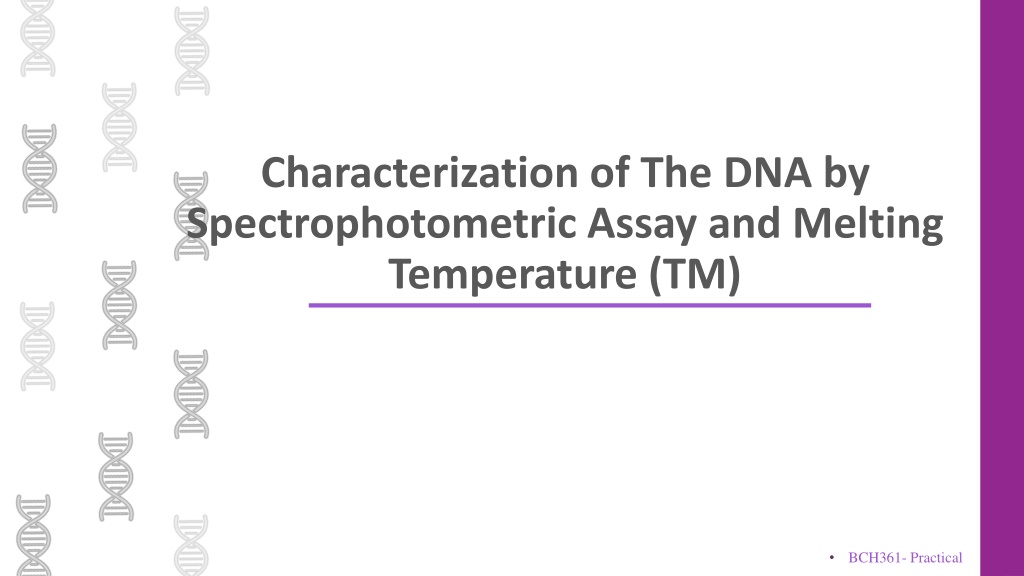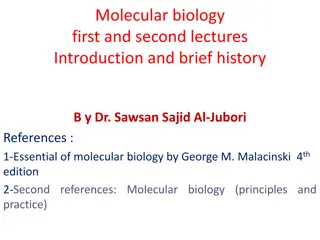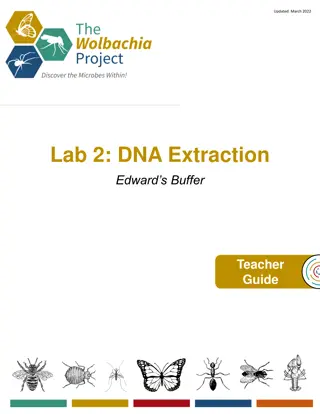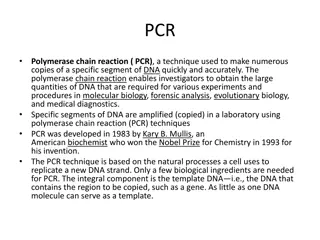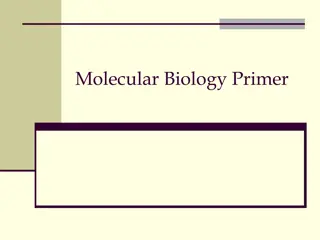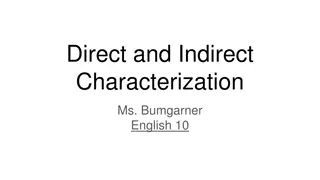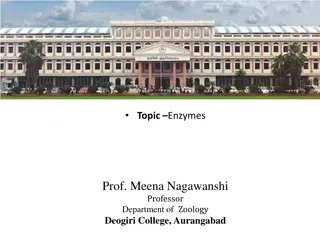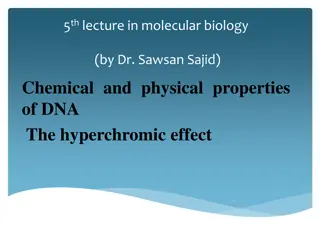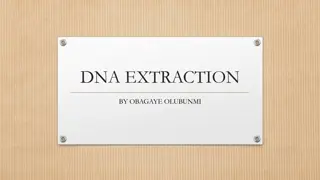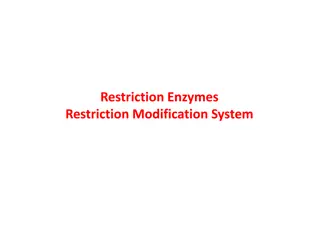Comprehensive DNA Characterization Methods in Molecular Biology
Explore the various techniques involved in the characterization of DNA, including spectrophotometric assay, melting temperature determination, quantitative and qualitative analyses, DNA purity assessment, GC content calculation, and DNA denaturation processes. Learn how to determine DNA concentration, detect contaminants, calculate GC content, and analyze DNA melting curves for understanding DNA stability.
Download Presentation

Please find below an Image/Link to download the presentation.
The content on the website is provided AS IS for your information and personal use only. It may not be sold, licensed, or shared on other websites without obtaining consent from the author. Download presentation by click this link. If you encounter any issues during the download, it is possible that the publisher has removed the file from their server.
E N D
Presentation Transcript
Characterization of The DNA by Spectrophotometric Assay and Melting Temperature (TM) BCH361- Practical
What NEXT, After DNA Extraction DNA characterization Quantitative analysis, using Qualitative analysis, using Agarose gel electrophoresis spectrophotometer DNA integrity and its size. DNA purity and concentration GC content Determine Tm 2
1. Determination of DNA concentration Is determined by measuring absorbance at 260 nm. Why? At 260 nm double-stranded DNA has specific absorption coefficient of 0.02 ( g/ml)-1cm-1. So: Concentration of DNA= (A260 / L) x Dilution Factor (DF). Beer Lambert Law: A = cl 3
2. DNA purity: 1. To detect nucleic acid purity from proteins contamination: Calculate A260/A280 Highly purified DNA samples have a A260/A280 nm ratio of (1.8-1.9). What if the ration is below 1.8? What that means? A high ratio (typically around 1.8-2.0) indicates relatively pure nucleic acid, while lower ratios suggest the presence of contaminants. 2. To detect nucleic acid purity from carbohydrates,salts, peptides, ethanol or any organic compounds: Calculate A260/A230 Purified DNA samples have a A260/A230 nm ratio of (2-2.2). 4
Denaturation or melting of a DNA: is when the double-stranded DNA (dsDNA) unwinds {dissociated "melted"} and separates into single-stranded (ssDNA) by heat or altered pH, which breaks the hydrogen bonds between complementary bases (A T and G C). If we cooldown the separated DNA solution? DNA strands can re-anneal or reassociate to form double-stranded DNA again. But>>> 6
3. GC content and melting temperature : The melting temperature (Tm) is the temperature at which 50% of the DNA strand is unpaired (denatured). Note: The Tm is depending on both length of DNA molecule and its GC content. Hyperchromic and hypochromic effect. GC content: what does it mean? And how to calculate it GC content can be calculated by generating Tm profile (DNA melting curve). %(G+C) = 2.44 (Tm - 69.3) 7
Relationship between Tm and GC%: What do you notice in the relation between GC content and Tm? 9
AIM: Determination the concentration and purity of extracted DNA using spectrophotometer. Determination of DNA melting temperature and GC content percentage. PRINCIPLE: - dsDNA will be separated to ssDNA by heat (denaturation). O.D at 260 nm will increase during denaturation... Why? - Temperature for midpoint of denaturation gives Tm. Why it is important to know Tm of DNA? The DNA of each species has a specific denaturation curve.. Why? 11
Results: Results: As in the lab sheet 12
